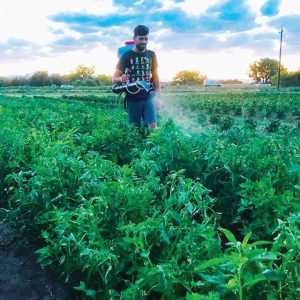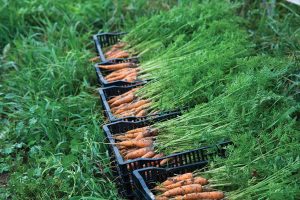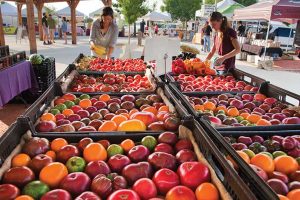Local farmers know healthy soil is where it all starts–here are their tips to improve yours
16 Oct 2019
Hitting pay dirt
By Camille Wilson Most people can detect the flavor difference between a tomato from their garden and one from a grocery store. That flavor difference also indicates a disparity in health benefits, and studies show that the nutrient density in commercially produced fruits and vegetables is declining. In fact, some estimates show a drop of 30% or more, depending on the nutrient. One study, published in the “Journal of the American College of Nutrition,” looked at 43 different vegetables over a span of nearly 50 years and found declines in iron, calcium, vitamin C, protein, phosphorus and riboflavin (vitamin B2). The University of Texas scientists who conducted the study attribute the changes, in part, to commercial farmers opting for crop varieties that favor higher yield and faster growth—so fast that the plants cannot produce or take up needed nutrients from the soil. Other scientists believe the biggest issue is the soil itself.

Feed Your Soil
Dreistadt views her land as a living, connected system and works hard to ensure healthy plants, animals, water and soil. There are many ways to return minerals to the soil that don’t involve chemical fertilizers, she says. “Ultimately, it’s the soil that determines the health of everything that grows out of it,” she says. “For a newer garden, buying organic compost is OK...and then you can make compost from your own yard, which is going to be the best at building your own fertility. What you create in your own ecosystem is going to feed your soil better than anything you can purchase.”Resources
Aspen Moon Farm (aspenmoonfarm.com) Sells organic biodynamic seeds and starter plants Farmstand: 7927 Hygiene Road, Longmont Boulder County Farmers Market: (Boulder) Wednesday and Saturday (Longmont) Saturday Josephine Porter Institute (jpibiodynamics.org) Source to purchase biodynamic preparations. MASA Seed Foundation (masaseedfoundation.org) Boulder-based source for organic produce seeds specifically adapted to Colorado. Ollin Farms (ollinfarms.com) Sells a cover-crop seed mix. Farmstand: 8627 N. 95th St., Longmont (quarter-mile south of Colorado Highway 119 and Hover Street) Boulder County Farmers Market: (Boulder) Wednesday and Saturday (Longmont) Saturday
She would love to see more home gardeners apply biodynamic preparations to their soil. These are mineral, plant or animal manure extracts, usually fermented and applied after specific dilution and stirring procedures. Gardeners can make their own preparations or buy them, and the payoff is evident in a plant’s nutrient content and vibrancy, according to Dreistadt. “You can see it, you can taste it and you can feel it when you eat the food,” she says. She also recommends covering the soil with cover crops—buckwheat for summer coverage, and rye, hairy vetch or oats in the winter. These feed the soil and keep it covered, and their roots keep topsoil from blowing away. Guttridge of Longmont’s Ollin Farms agrees cover crops are a critical part of soil health. He and his team use a specially blended seed mix containing winter rye and Austrian field peas, among other plants, on their family-run fields, and gardeners can buy this mix from their farmstand. “Mulching with fall leaves is OK for the home garden, but using a cover crop gives your soil extra photosynthesis,” Guttridge says. “More diversity above the soil creates more diversity under the soil.” In spring he suggests mowing the cover crop and leaving it to rest. This creates a green “manure” that further acts as its own amendment when tilled into the soil.
Feed Your Plants
Because nutrient-dense plants help maintain nutrient-dense soil, Guttridge says nutrient drenches and foliar (leaf) spraying at “critical points of influence” for plant success can, in turn, impact soil health. A drench is specially formulated by dissolving nutrients in water that are required for whatever plant is being grown. The drench is poured at the base of plants to provide targeted, deep penetraion. The content of his drenches vary, since different crops require different nutrients and are planted in different soils, but his farm often creates a general drench for seedlings before transplanting them to the fields. The drench acts like a multivitamin, and Guttridge prefers it to fertilizers because it is more nutrient-specific and does not force-feed the plants. He also mists Ollin’s fields with a needs-specific foliar spray several weeks after planting when different species begin to flower. This technique compensates for identified deficiencies using minerals and microbial nutrients brewed into a liquid form and misted onto plants’ leaves, rather than poured on the soil.Choose Local
Local heirloom varieties of fruits and vegetables are often slower growing, which allows them to establish better roots and higher nutrient content. They’re also better adapted to the particular climate and soil conditions in our area. Plant your own seeds from a previous season or purchase organic seeds from local farms and seed banks. If growing starter plants, avoid buying them from large chain stores because bee-harming chemicals (neonicotinoids) are already inside the stem and systems of these plants. Instead, opt for local organic starter plants available at the Boulder County Farmers Markets, Growing Gardens, on-site farmstands and elsewhere.












